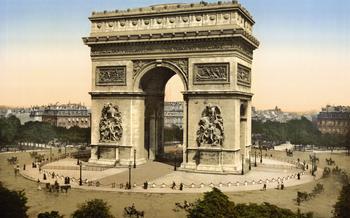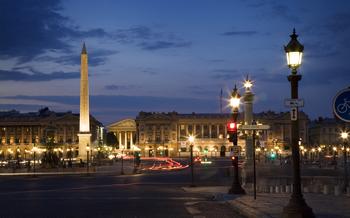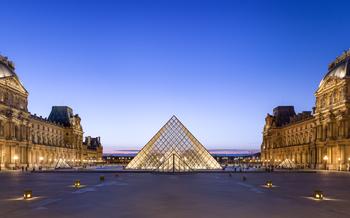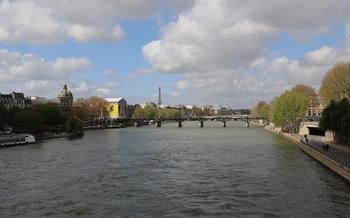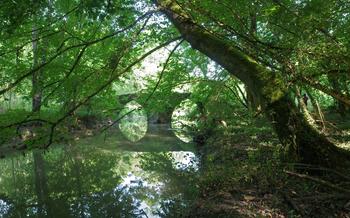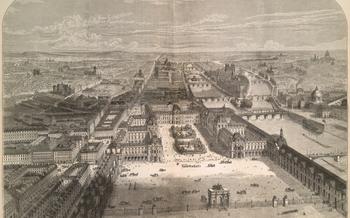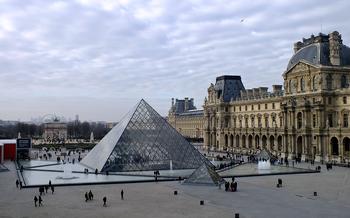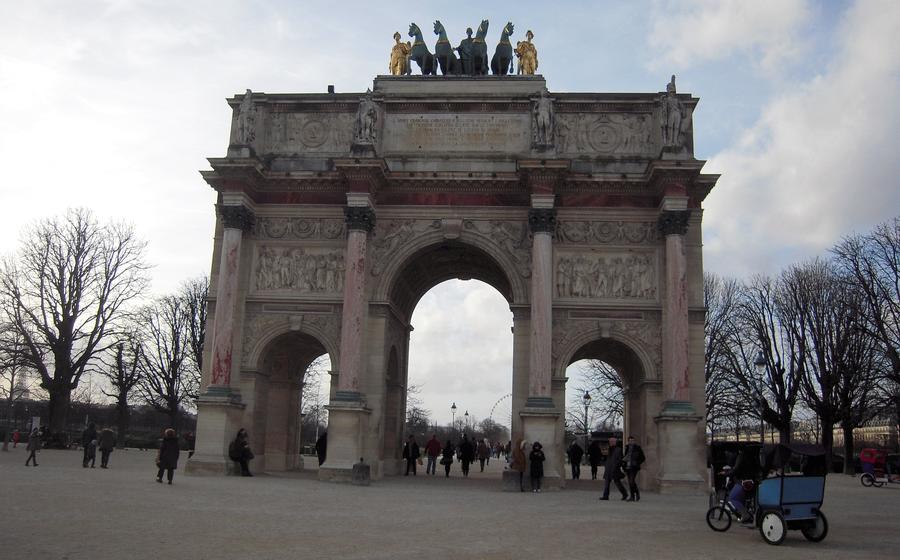
Arc de Triomphe
- The Arc de Triomphe: A Monumental Masterpiece
- Location and Accessibility
- History and Construction
- Architectural Features
- The Tomb of the Unknown Soldier: A Tribute to the Fallen
- Panoramic Views from the Observation Deck
- Changing of the Guard Ceremony
- Exploring the Champs-Élysées
- Visiting the Nearby Landmarks
- Events and Exhibitions
- Practical Information
- Tips for Your Visit
- Photography Enthusiasts' Paradise
- Historical Context and Significance
- Insider Tip: Hidden Gems Nearby
The Arc de Triomphe: A Monumental Masterpiece
Standing tall at the western end of the Champs-Élysées, the Arc de Triomphe is an iconic symbol of Paris, France. This monumental arch, commissioned by Napoleon Bonaparte in 1806 to commemorate his military victories, is a testament to French pride and architectural prowess. Despite its completion after Napoleon's death in 1821, the Arc de Triomphe remains a timeless tribute to the French nation and its rich history.
Modeled after the triumphal arches of ancient Rome, the Arc de Triomphe is a masterpiece of neoclassical architecture. Its imposing archway, measuring 50 meters high and 45 meters wide, is adorned with intricate carvings and sculptures depicting historical events and allegorical figures. Atop the arch stands a majestic quadriga, a four-horse chariot symbolizing the triumph of peace.
Beyond its architectural grandeur, the Arc de Triomphe holds immense historical significance. It serves as a poignant reminder of the sacrifices made by French soldiers throughout history. Beneath the arch lies the Tomb of the Unknown Soldier, honoring those who perished in World Wars I and II. An eternal flame burns continuously, symbolizing remembrance, gratitude, and the enduring spirit of the French people.
Location and Accessibility
The Arc de Triomphe, a majestic symbol of French national pride, stands tall at the western end of the Champs-Élysées, the most famous avenue in Paris. This iconic landmark is situated in the heart of the city, offering easy access via various transportation options.
Multiple metro lines, including the M1, M2, and M6, have stops near the Arc de Triomphe, making it convenient to reach using the Paris Metro network. Additionally, the RER A regional express train line has a station at Charles de Gaulle-Étoile, just a short walk from the arch.
For those preferring buses, numerous lines, including the 22, 30, 31, 52, 73, and 92, stop in the vicinity of the Arc de Triomphe. These buses provide connections to various parts of Paris, ensuring easy accessibility from different neighborhoods.
With its central location and excellent public transportation links, the Arc de Triomphe is effortlessly accessible to visitors from all corners of Paris. Whether you choose to arrive by metro, RER, or bus, you'll find yourself at the doorstep of this awe-inspiring monument in no time.
History and Construction
The Arc de Triomphe, a testament to French architectural prowess, owes its existence to the vision of Napoleon I. Conceived as a monument to commemorate the victories of his Grande Armée, the arch's design was entrusted to the renowned architect Jean Chalgrin. The foundation stone was laid in 1806, but its completion would elude Napoleon, who died in 182The arch, a symbol of national pride, was finally inaugurated in 1836 under King Louis-Philippe.
The Arc de Triomphe stands as a testament to the perseverance and dedication of the French people. Despite numerous challenges, including the political turmoil of the French Revolution and the Napoleonic Wars, the arch was meticulously constructed over several decades. The result is a masterpiece of neoclassical architecture, adorned with intricate sculptures and carvings that narrate the history of France and its military triumphs.
Architectural Features
The Arc de Triomphe stands as a testament to architectural grandeur, embodying the essence of Neoclassical design. Its imposing archway, soaring 50 meters high and spanning 45 meters wide, commands attention from afar. The arch's surface is adorned with intricate carvings and sculptures, a testament to the skill and artistry of the era's finest craftsmen. These intricate details depict historical events, allegorical figures, and military triumphs, narrating the story of France's rich past.
Crowning the arch is a majestic quadriga, a four-horse chariot driven by the goddess of victory, Nike. This awe-inspiring sculpture symbolizes the triumph of peace and the indomitable spirit of the French nation. The quadriga, measuring an impressive 12 meters in height, is a masterpiece of bronze casting, capturing the essence of movement and power.
The Arc de Triomphe's architectural precision and grandeur have earned it a place among the world's most iconic monuments. Its harmonious proportions and intricate details continue to inspire architects and designers, serving as a timeless symbol of architectural excellence.
The Tomb of the Unknown Soldier: A Tribute to the Fallen
Beneath the majestic Arc de Triomphe lies a poignant tribute to French soldiers who paid the ultimate sacrifice in World Wars I and II—the Tomb of the Unknown Soldier. This sacred space, inaugurated in 1921, serves as a solemn reminder of the human cost of war and the unwavering spirit of those who fought for their country.
At the heart of the tomb, an eternal flame burns continuously, symbolizing the everlasting memory and gratitude of the French nation. This flame, meticulously tended by war veterans, serves as a beacon of hope and remembrance, illuminating the names of fallen soldiers inscribed on the surrounding walls.
Every year, on November 11th, Armistice Day, a solemn ceremony is held at the tomb to honor the sacrifices of French soldiers. Wreaths are laid, speeches are given, and a minute of silence is observed, allowing visitors to reflect on the profound impact of war and the importance of peace.
The Tomb of the Unknown Soldier is a powerful reminder of the human cost of conflict and the enduring legacy of those who have fought for their country. It is a place of reflection, remembrance, and gratitude, where visitors can pay their respects to the fallen and honor the spirit of national unity and sacrifice.
Panoramic Views from the Observation Deck
Ascend the 284 steps to the observation deck of the Arc de Triomphe, or take the elevator for a more leisurely ascent. The panoramic vistas that await are truly breathtaking, offering a bird's-eye perspective of Paris's most iconic landmarks.
From this elevated vantage point, the Eiffel Tower stands tall to the southwest, its intricate latticework reaching towards the heavens. To the east, the Louvre Museum's glass pyramid peeks out from behind the historic rooftops of the city. Northward, the white domes of the Sacré-Cœur Basilica crown the hill of Montmartre, while to the west, the sprawling cityscape extends as far as the eye can see.
Capture the essence of Paris in a single panoramic shot, framing the Eiffel Tower, the Louvre, and the Sacré-Cœur in one breathtaking composition. The golden light of sunrise and sunset casts a magical glow upon the city, creating unforgettable photo opportunities that will forever immortalize your visit to the Arc de Triomphe.
Changing of the Guard Ceremony
Every hour, on the hour, the Arc de Triomphe becomes the stage for a solemn and moving ceremony: the Changing of the Guard. Soldiers in their traditional uniforms, their faces etched with determination and pride, march in perfect synchrony, honoring the memory of those who gave their lives for their country. The rhythmic cadence of their footsteps echoes through the archway, creating a palpable sense of patriotism and reverence.
With each step, the soldiers pay tribute to the fallen heroes, their sacrifice etched in the very stones of the monument. The ceremony is a poignant reminder of the sacrifices made by those who have served and protected their nation, and it serves as a powerful symbol of the enduring spirit of France.
As the new guard takes its position, the old guard departs, their duty fulfilled. The changing of the guard is a sacred ritual, a solemn passing of the torch from one generation of soldiers to the next, ensuring that the memory of the fallen will never be forgotten.
Exploring the Champs-Élysées
After admiring the grandeur of the Arc de Triomphe, take a leisurely stroll along the iconic Champs-Élysées, a vibrant boulevard pulsating with life and energy. This grand avenue stretches from the Place de la Concorde to the Arc de Triomphe, showcasing the best of Parisian elegance and charm.
Immerse yourself in the vibrant atmosphere as you walk past elegant boutiques, renowned cafes, and historic theaters. Marvel at the architectural masterpieces that line the boulevard, including the Grand Palais and Petit Palais, which host prestigious exhibitions and events throughout the year.
Indulge in some retail therapy at the numerous luxury stores, or simply relax and people-watch at one of the many cafes, sipping on a cup of coffee and soaking in the Parisian ambiance. The Champs-Élysées is also a popular spot for street performers and musicians, adding to the lively atmosphere.
Don't miss the opportunity to visit the nearby Palais de la Découverte, a science museum that offers interactive exhibits and hands-on activities for visitors of all ages. It's a great place to learn about the wonders of science and technology in a fun and engaging way.
As you stroll along the Champs-Élysées, you'll be captivated by its vibrant energy and charm. It's a must-visit destination for anyone seeking a quintessential Parisian experience.
Visiting the Nearby Landmarks
The central location of the Arc de Triomphe makes it an ideal starting point for exploring other iconic landmarks in Paris. Situated at the western end of the Champs-Élysées, visitors can embark on a leisurely stroll along this grand boulevard, admiring the elegant architecture and vibrant atmosphere.
Within walking distance, discover the world-renowned Louvre Museum, home to masterpieces such as the Mona Lisa and Venus de Milo. Marvel at the impressive collection of art and artifacts that span centuries of history.
Just across the Seine River, visit the Palais de Chaillot, a magnificent palace that houses several museums, including the Musée de l'Homme and the Musée de la Marine. Take in the stunning views of the Eiffel Tower from the Trocadéro Gardens, a popular spot for picnics and taking memorable photographs.
Another nearby attraction is the Place de la Concorde, one of the largest squares in Paris. Admire the majestic obelisk brought from Egypt and the beautiful fountains that adorn the square. From here, you can continue your exploration of the city's rich history and culture by visiting the Grand Palais or the Petit Palais, both renowned for their architectural splendor and cultural exhibitions.
Events and Exhibitions
The Arc de Triomphe not only stands as a testament to French history and military prowess but also serves as a vibrant cultural hub. Throughout the year, the arch hosts a variety of temporary exhibitions and events that delve into its rich history, architecture, and significance. These events offer visitors a unique opportunity to gain deeper insights into the iconic monument and its role in shaping the identity of Paris.
Check the official website of the Arc de Triomphe to stay informed about upcoming events and exhibitions. From captivating historical displays to contemporary art installations, there's always something new and exciting to discover at this Parisian landmark. Don't miss the chance to enrich your visit with these special events and exhibitions that bring the Arc de Triomphe to life in new and unexpected ways.
Practical Information
Before embarking on your visit to the Arc de Triomphe, it's essential to plan ahead. Operating hours are daily from 10:00 AM to 11:00 PM, allowing ample time to explore the monument and its surroundings. Admission fees vary depending on age and status. Adults pay a standard rate of €13, while visitors under 18 enjoy free entry. A reduced rate of €10 is available for students and seniors. Accessibility is a priority at the Arc de Triomphe, with an elevator catering to visitors with disabilities, ensuring an inclusive and enjoyable experience for all.
Tips for Your Visit
Arrive Early: To avoid the throngs of tourists, particularly during the height of the tourist season, it is advisable to arrive early. This will ensure a more serene experience, allowing you to fully appreciate the grandeur of the Arc de Triomphe without feeling overwhelmed by crowds.
Book Tickets Online: Take advantage of the convenience of online ticket booking to bypass the queues and secure your entry. This will save you precious time and allow you to proceed directly to the monument, without the hassle of waiting in line.
Comfortable Shoes: Considering the number of steps you will need to climb to reach the observation deck, it is essential to wear comfortable shoes. This will ensure a comfortable and enjoyable experience as you ascend the stairs.
Capture Panoramic Shots: The observation deck of the Arc de Triomphe offers unparalleled views of Paris, making it a photographer's paradise. Capture breathtaking panoramic shots of the city's iconic landmarks, including the Eiffel Tower, the Louvre Museum, and the Sacré-Cœur Basilica.
Photography Enthusiasts' Paradise
The Arc de Triomphe is a dream come true for photography enthusiasts, offering a plethora of captivating angles and perspectives to capture the essence of Paris. With its imposing architecture and iconic location, the arch becomes a magnificent subject in itself, especially when juxtaposed against the ever-changing Parisian skyline. Photographers can unleash their creativity, experimenting with different lighting conditions to capture the monument's grandeur at sunrise, sunset, or even at night when it's illuminated against the dark sky. The observation deck provides a unique vantage point, allowing photographers to capture breathtaking panoramic shots of the city, encompassing famous landmarks like the Eiffel Tower, the Louvre, and the Sacré-Cœur Basilica. Whether you're an amateur or a professional photographer, the Arc de Triomphe offers endless opportunities to create stunning and memorable images that will forever capture the essence of your Parisian adventure.
Historical Context and Significance
The Arc de Triomphe stands not only as an architectural masterpiece but also as a symbol of France's rich history and national pride. To fully appreciate its significance, it is essential to understand the historical context surrounding its construction.
Commissioned by Napoleon Bonaparte in 1806 to commemorate his victory at the Battle of Austerlitz, the arch was initially intended to glorify the emperor and his military achievements. However, Napoleon's defeat at Waterloo in 1815 brought the project to a halt. It was later revived under King Louis-Philippe in 1833, who dedicated it to all those who fought for France during the Napoleonic Wars.
The arch's intricate carvings and sculptures depict scenes of triumph and military prowess, reflecting the prevailing sentiment of patriotism and national pride during the 19th century. It also bears the names of French victories and generals, serving as a reminder of the country's glorious military history.
Understanding the historical context of the Arc de Triomphe enhances one's appreciation of its significance as a national monument and a symbol of France's resilience and spirit.
Insider Tip: Hidden Gems Nearby
While exploring the Arc de Triomphe, don't miss the opportunity to uncover the hidden gems nestled in its vicinity. Just a short walk away, discover the Musée Dapper, a treasure trove dedicated to African art and culture. Immerse yourself in captivating exhibitions showcasing diverse artifacts, sculptures, and contemporary artworks from across the continent.
Venture into the Parc de Monceau, an enchanting hidden gem, where tranquil gardens and picturesque sculptures await. Stroll along its winding paths, admire the blooming flowers, and find respite from the bustling city.
Indulge in the authentic flavors of French cuisine at one of the charming bistros lining the surrounding streets. Savor delectable dishes, sip on a glass of wine, and soak in the vibrant atmosphere of Parisian life. These culinary havens offer a taste of true Parisian gastronomy and a chance to mingle with locals.
